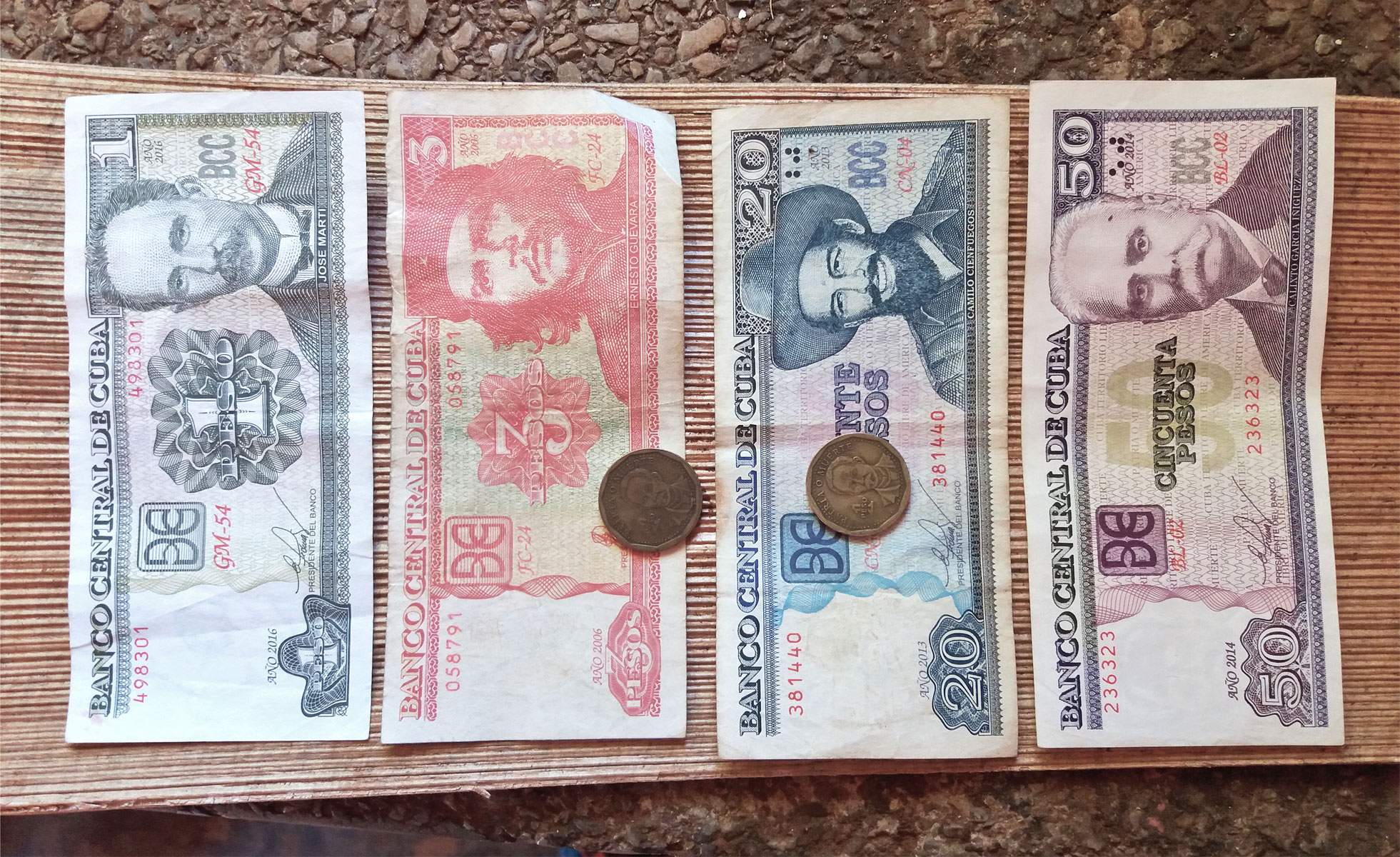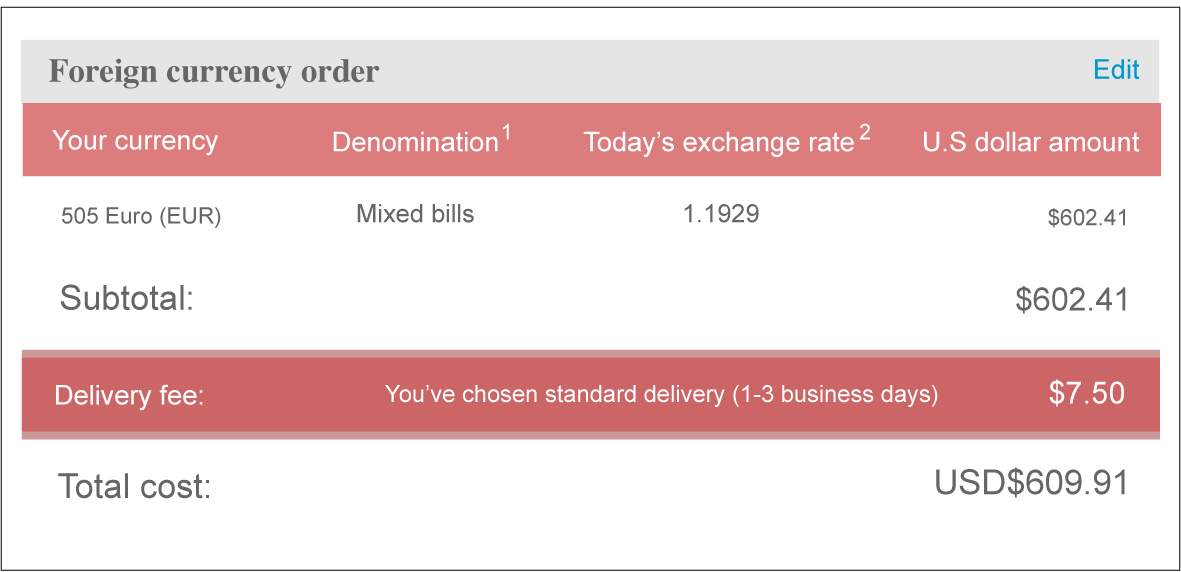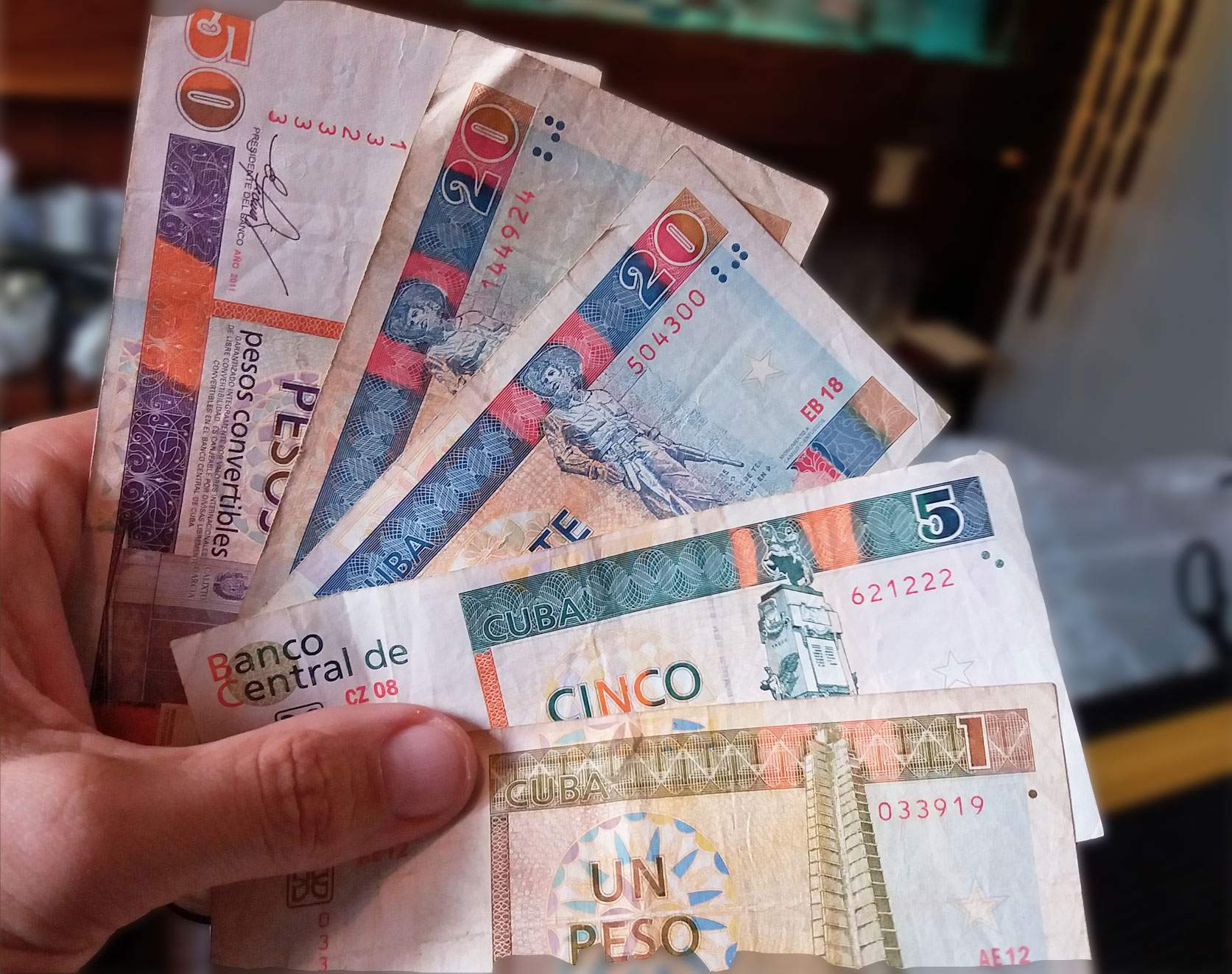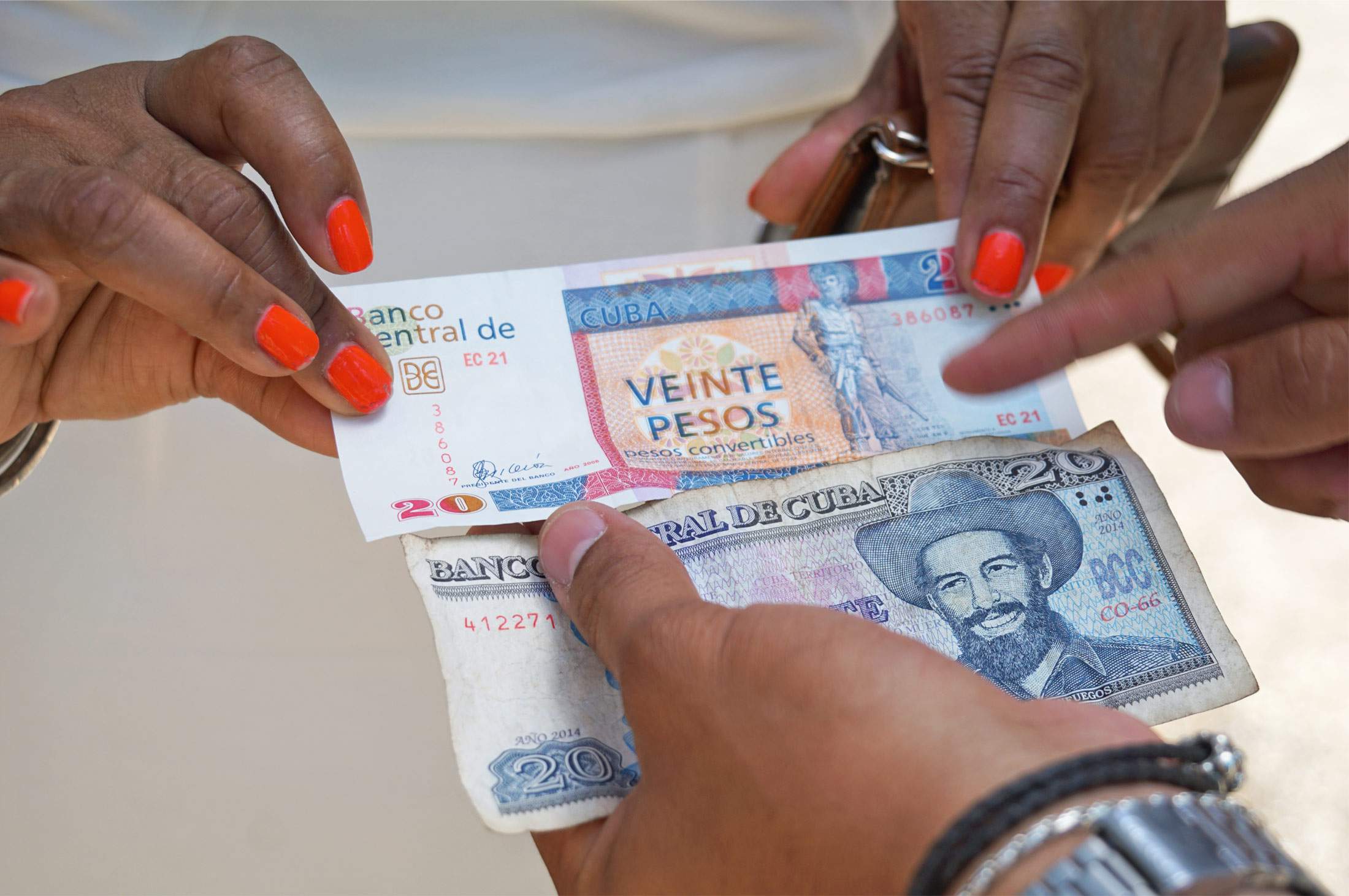
February, 2024
Contributor: Sarah Arizaga
In 2021 Cuba eliminated the CUC, drastically changing the Cuban economy. For current information on how to navigate Cuba's currency situation, see the article 5 Tips for Navigating Currency in Cuba in 2024
The number one topic of uncertainty for travelers to Cuba is the currency situation. Over and over again, from our clients, in the travel groups, on the streets in Cuba I hear people asking the same questions:
What currency should I bring to Cuba?
Where can I change my money?
Can I use US dollars in Cuba?
Can tourists use the local Cuban money?
And on and on… it’s a confusing topic because:
- Cuba operates on a dual currency system, the CUP and CUC
- Cuba charges different conversion fees for USD compared to all other currencies
- There are specific embargo related restrictions that US travelers have, but getting money in general in Cuba can be tricky
I’m not covering Cuban Money 101 here, but I want to tackle the three most common questions I hear. Let’s delve in, are you ready to do some math?
Should I bring EUROS, CAD, etc.?
The reason for this question is a little thing called the “To Heck With Your Embargo” tax. Ok, it’s not actually called that, but it is a 10% tax that the Cuban government charges for changing US dollars to Cuban currency. And it hurts.
Changing EUR, CAD, GBP or any other currency you will be charged 3%
Changing USD you’ll be charged that same 3% conversion fee PLUS 10% tax, for a total of 13%
Since the CUC is pegged to USD 1:1, after the fees you’re getting only 87CUC for the crisp clean $100 bill you gave, a loss of $13. Sucks right? So should you bring a different currency instead?
Ehhh…no.
Short Answer: Don’t bother
Why? Because you aren’t going to be saving very much- only 3-4%. Also, and most importantly, US dollars are in really high demand right now, so you can exchange them unofficially for 1:1. Some people have even gotten as high as 1.20CUC per dollar on the streets. By “on the streets” I don’t mean for you to look for a dark alley to exchange in, you can ask your casa owners if they know of someone, or airport workers, waiters, and various other people you meet will want to trade with you. But if you are a strictly by-the-book person and don’t want to exchange outside of official channels, I still don’t recommend you go to the effort to bring a foreign currency to Cuba. Let’s do a real-life example so you can see why (if you aren’t into math, skip to next section):

Bank of America foreign currency purchase transaction
The above picture is of a Bank of America foreign currency transaction. You can see that to buy about €500 it will cost approximately US$610 once you factor in the exchange rate and the US$7.50 delivery fee. These fees are going to be standard for most major US banks.
When you exchange those EUR to CUC at today’s exchange rate you will receive 551CUC (€1 is equal to 1.10257CUC)
For the same amount $610 you would have received 532CUC, so you have saved $21
$610 x .87250 = 532CUC
$610 -> €500 x 1.10257 = 551CUC
Total savings $24
Instead of paying 13% in penalties, you’ve paid 10%
Or, in other words
You got 90CUC per $100 instead of 87CUC per $100. Congrats! You’ve saved 3%. But now you may be stuck with Euros that you have to change back and that’s a whole ‘nother set of exchange losses.
If it’s worth the trouble to you and the numbers work in your favor, do it. You will generally save 3%-4% if you have favorable bank fees and exchange rates. If you have foreign currency lying around, DEFINITELY do it. If you have to buy it, maybe only bring to Cuba about half of what you think you’ll need in a foreign currency so you don’t have any left to change back. Remember too that the math on USD is pretty easy, and gets more complicated with other currencies. Anytime you go to buy currency in Cuba you need to do the math ahead of time so you know how much they owe you. Many people get ripped off if they aren’t paying attention.
My personal tip is to just bring USD and ask the owner of your casa if they want to exchange with you. I’d say this works for me about half the time. Generally, they pay 90-94CUC and it’s a win-win. You can also try buying CUC from people in the Cadeca exchange line at the departure airport. They want to get rid of CUC, you want to buy it, another win-win! By the way, if someone approaches you in line and proposes this, don’t look at them like they are selling gold watches in a gas station parking lot. They just want to score that win-win and it’s probably me.
Where do I get CUC?
Your first opportunity will be in the Havana airport. The Cadeca (exchange house) there is open as long as flights are scheduled, so don’t worry about what day or hour you arrive.

CUC are worth more than dollars
CUC has no value outside of Cuba and banks don’t sell them. FYI- it is illegal to bring CUC into or out of the country, as of November 2019 they began cracking down on this and your CUC may get confiscated at the airport. It’s surely going right into the airport employee’s pocket. If you are going to take your leftover CUC home, don’t keep it in an obvious place like your pocket or wallet. You can’t use CUC in the airport, only USD, EUR, CAD, and CUP are accepted in the cafeterias and duty-free although in Terminal 3 prior to security you can use CUC.
Pro-Tip: Unload your CUC before you get to the airport, the line to exchange can be extreme, some waiting 2hrs or more. Also, bring $1s and $5s to buy snacks at the cafeteria since they aren’t likely to be able to give you change in USD.
Cadecas are the government run currency exchange houses in Cuba, usually open 7 days a week but close early on Sundays. These are most convenient exchange places and in every town we visit. Banks are also an option to exchange. Both generally offer the same rates that are set by the government. Hotels in Cuba often have exchange services but it can be slightly more expensive. My favorite option, as mentioned above, is to exchange with your casa owner or another trusted individual.
You must bring cash. You cannot use debit or credit cards in Cuba.
Trust me on this, bring more than you think you’ll need. Cuba is more expensive than you expect and I hear travelers comment on this all the time. The place is a sieve for money and I’ve found myself at the end of the day wondering how I spent so much. If you’re on one of our SCP tours you’ve got a lot included, but still bring about $60/day, if you’re on your own you need $100/day. Don’t change it all at once, do it in increments of $200-$300, that way you won’t be left with a lot at the end.
Bring crisp clean $100s, no marks, no tears.
You don’t want to find that out of your $600, only $300 is usable. There are some eagle-eye employees at the Cadeca, and any pen mark is likely to disqualify the bill. You will need your passport, or a photocopy or photo of it to exchange money. You can bring smaller denominations but 100s are the most convenient.
Previously I wouldn’t have encouraged travelers to try to pay with USD because it would be an inconvenience for Cubans to have to exchange it to CUC, but now with the previously mentioned high demand for dollars, it could be that it’s the preferred currency. In October 2019 the Cuban government opened “dollar stores” where Cubans could purchase items (mostly home appliances) at a discount by paying in foreign currency. These stores, and the looming demise of the CUC as part of currency unification plans, mean that vendors may gladly accept your USD. You should not rely on this though, make sure to have at least some CUC. Also, if you are paying in USD at a restaurant, you may be paying that 13% exchange tax, in which case you’d have been better off paying with your CUC that you purchased 1:1. Note that in the airport you will only be able to use USD/CAD/EUR/CUP, so get rid of your CUC before you hop in that taxi to the airport.
What is CUP? I am allowed to use it?
Cuban Pesos (CUP) aka Moneda Nacional (MN) is the currency that most locals are paid in, and what they use for essential goods such as rationed food, utilities, etc. If it’s priced in MN it’s aimed at locals. Foreigner aimed goods and services, as well as better quality and imported products for Cubans are priced in CUC.

You may be willing to pay $5 for a piña colada in Cuba, but it’s 5MN, which is actually 20 cents!
As far as tourists are concerned, MN is an easy scam. It’s common for tourists to think that a price is in Cuban Convertible Pesos (CUC) when it’s actually in MN, or to pay for something in CUC only to receive change in MN. An honest person will make sure you get your change in the proper amount, no matter which currency they give you, but the temptation is too great for many to resist. Don’t feel bad if you get scammed with this in Cuba, it happens to nearly everyone. My own mother fell victim despite my warnings.
Ready for more math?
1CUC=1USD
25CUP=1CUC=1USD (when selling CUC it’s 24:1)
1CUP=.04CUC/USD
5CUP=.25CUC/USD
10CUP=.50CUC/USD
Why am I breaking it down like this? Because if you memorize these amounts it will help you know what things cost. I’m talking to you budget travelers!
Yes, you can use MN (but you don’t need to)
Anyone can use either currency but it’s not necessary, because CUC is accepted everywhere in Cuba, and MN is only accepted at certain places. The only thing tourists will buy in MN is street food or collective taxi rides. But if I want to buy a street pizza for 12MN, I can pay with 1CUC, and I should get back about .50CUC or 12MN. If you aren’t sure whether the price is in MN or CUC, ask yourself- is it expensive? Are locals buying it? If 5CUC for a cup of juice seems high (this ain’t Jamba Juice) then you can be sure it’s in MN.

Buying street snacks is a good way to use your Cuban pesos
If you want to have some MN for the novelty of it you can change at any Cadeca except at the airport. I don’t recommend changing more than 5CUC at a time (120MN), that should be more than enough to give you that local experience.
Big Head = Small Value
So how do you identify which is which? It’s easy. If your bill has a portrait of someone (big head) it’s CUP, if it shows a statue it’s CUC. The CUP coins are light and seem fake, like play money (with about the same value). CUC coins feel legit. Now you know.

The bill on the bottom is worth about $1, the bill on the top is worth $20, don’t mix them up!
Happy spending!




Comments
Be the first to comment!